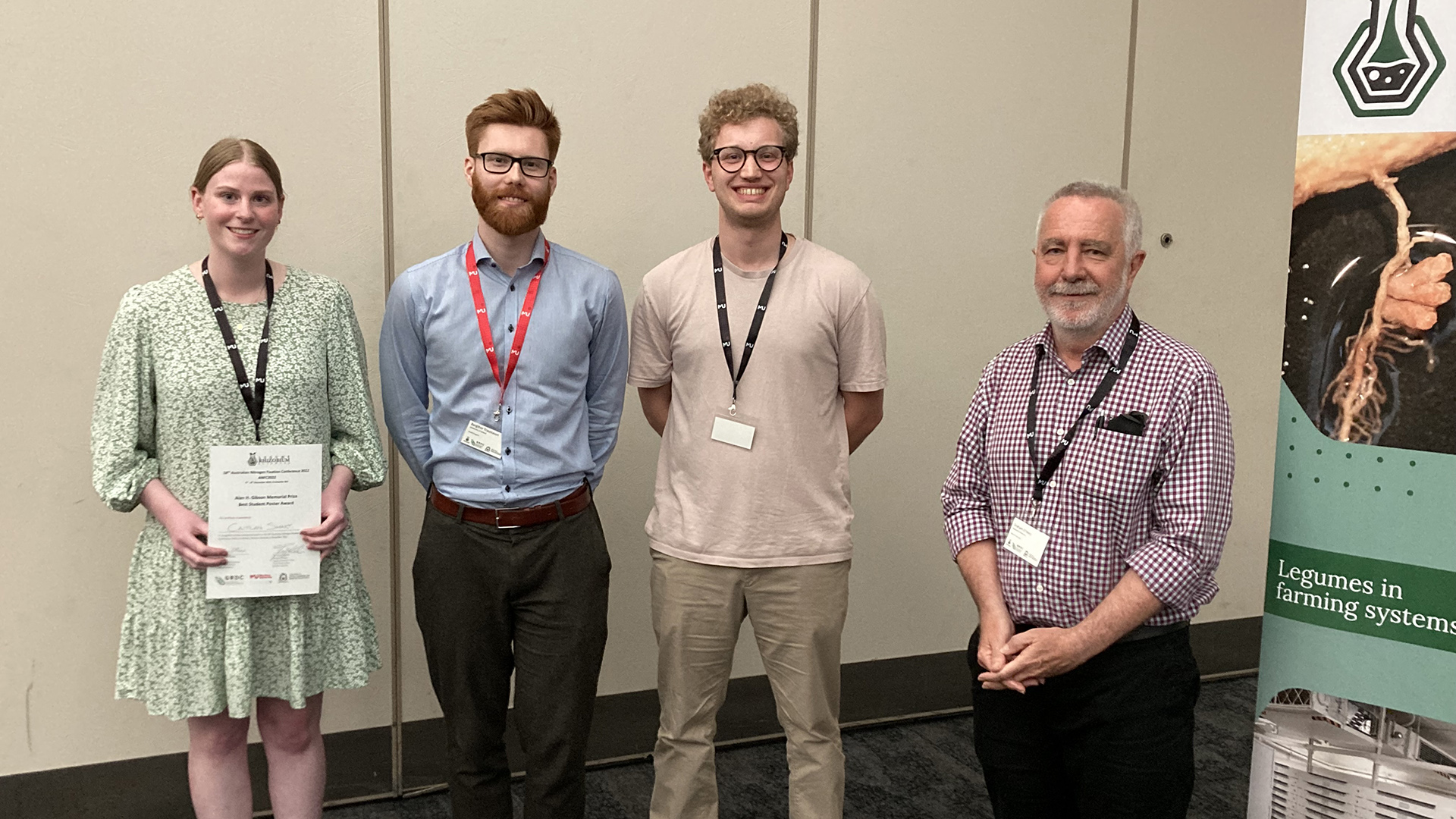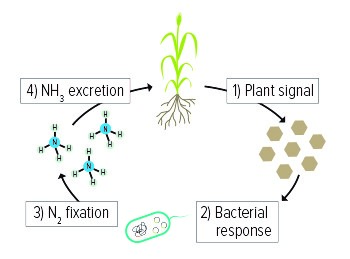Fresh eyes, mental frame shifts and drawing on the wealth of experience of an interested colleague can be a great catalyst for that ‘eureka’ moment.
Those were the words of Dr Jason Terpolilli, who welcomed delegates to the 18th Australian Nitrogen Fixation Conference (ANFC) convened at Fremantle in late 2022.
With support from GRDC, the Western Australian Department of Primary Industries and Regional Development (DPIRD) and Murdoch University’s Food Futures Institute, the conference saw 85 delegates gather over four days. The delegates were drawn from Australia, the UK, South Africa, Canada, Chile, New Zealand and the US.
“The conference covered the whole gamut of symbiotic nitrogen fixation work,” Dr Terpolilli says. “From farming systems, nodule physiology, rhizobial metabolism, genetics, synthetic biology to inoculation practice.”
Farming systems
Following an opening address by senior GRDC regional manager - West, Peter Bird, Professor John Howieson from the Legume Rhizobium Sciences (LRS) team at Murdoch University set the agenda with a paper entitled ‘The ascent of legumes in farming systems: the critical role of wisdom, weeds and women’.
Professor Howieson is an internationally recognised expert in sustainable agriculture specialising in nitrogen fixation of legume crops. He has been instrumental in identifying and developing new pasture and forage species adapted to Australian environments.
He told the conference that the accumulation of wisdom about growing legumes has clearly identified the niche environmental situations where different species are best-adapted and has informed the best fit for growers and their production systems. Weeds continue to be a challenge to manage in legume and pulse crops, as they not only can reduce yields but also lower the market value.
Why does Professor Howieson say women play a critical role in adoption of legumes? Because, overwhelmingly, women around the world are the innovators when it comes to accessing healthier diets, are often the livestock managers and have driven the need for legumes and pulses in farming systems.
Presentations on the importance of legumes in pastures and the critical role they play in providing nitrogen in crop sequences and farming systems were presented by the University of New England’s Professor David Herridge and Robert Harrison from DPIRD and Murdoch University’s LRS.
Farming system implications for legumes were discussed further by Tom Edwards, also representing DPIRD and LRS. Mr Edwards provided insights into the interactions between legumes and herbicides in WA’s sandy soils.
Due to the low levels of clay and organic matter in these soils, there is little binding of herbicides; consequently, herbicides are more biologically available. This is further enhanced by low rainfall, meaning that there are slower rates of herbicide degradation.
Mr Edwards has determined that legume-rhizobia symbioses are particularly sensitive to many commonly applied herbicides and recommends that strategies be developed for herbicide use that reduce the impact on biological nitrogen fixation on these lighter-textured soils.
Robert Harrison, also representing DPIRD and LRS, presented findings quantifying how a selection of pasture legumes can boost cereal protein in dryland cropping systems. This work was part of the five-year, $18 million national Dryland Pasture Legume Systems project – a multi-institutional initiative led by GRDC that has been transformative in delivering improved pasture legume species for mixed farms in medium to low-rainfall zones.
Science of symbiosis
The conference highlighted the concerted effort of passionate people, according to conference committee member Dr Yvette Hill, who is also part of the LRS.
“Fundamental to harnessing the power of symbiotic nitrogen for farming systems is an in-depth understanding of the science underpinning symbiosis, encompassing genetics and physiology,” Dr Hill said.
“Several presentations showcased the latest understanding of the evolution and diversity of rhizobia and the biochemistry of rhizobia metabolism.”
Dr Beatriz Jorrin from the University of Oxford presented a new method of tracking multiple bacteria on plant roots, while Associate Professor Brett Ferguson from the University of Queensland has determined the molecular mechanisms driving the development and regulation of legume nodules.
Rhizobium symbiosis genes are encoded on pieces of DNA that can either integrate into the rhizobium chromosome or exist autonomously alongside it, and these genes are highly mobile, being able to transfer between inoculum and rhizobium strains in the soil.
Dr MacLean Kohlmeier (LRS) described work to completely sequence all 42 of the Australian commercial rhizobium inoculants. This is critical baseline data that will provide a blueprint to identify and track changes in inoculants over time.
“Not only will these inoculant sequence data be important for quality control of inoculant strains, but they will also enable us to build the capacity to identify the specific bacterium within a nodule and, possibly, the genetic elements that may indicate the potential for a new strain to be effective or poorly effective at fixing nitrogen,” Dr Kohlmeier said.
Inoculation practice
Nitrogen fixed by pulses and legumes is valued at about $12 billion per annum globally, with much of it fixed by rhizobia supplied by inoculants.
Several facilities promote commercial inoculant development in Australia. GRDC’s support of the development of the International Legume Inoculant Genebank at Murdoch University was emphasised in a presentation by Dr Terpolilli as a vital resource for not only Australia, but also worldwide.
Dr Jessica Rigg from the New South Wales Department of Primary Industries’ Australian Inoculants Research Group (AIRG) reported on the ongoing work providing Australia with a transparent industry-wide inoculant service. AIRG provides an independent testing service for legume inoculants against the standards outlined in the national code of practice for legume inoculant quality. Dr Rigg confirmed that products holding AIRG’s quality assurance Green Tick logo, independently tested and are of excellent quality.
Dr Ron Yates (DPIRD, LRS) reported on the replacement of inoculant for peas, lentils and vetch.
Capacity building
Dr Terpolilli said funding, laboratories, equipment and field studies are all needed to tackle the constraints of nitrogen fixation and its application into the future.
“But we have no hope of tackling any of these challenges if we do not attract bright and inquiring minds to build a career in this field,” he said.
“We were heartened to see so many student presenters at the conference from both within Australia and overseas. They have a real enthusiasm for legume-rhizobia science, and this showed in the very-high-quality work they presented.

Student delegates left to right (back row): Troy Miller, Talitha Rogers, Caitlin Smart, Rita De Kassia Guarnier, Kit Burns, Callum Verdonk, Nasir Iqbal, Tahlia Bastholm and Thomas Underwood. Left to right (front row): Rebecca Fudge, Marcus Chung, Jessie Dolliver, Georgina Stagg, Dinani Twite, Pinhui Wang and Clare Cocker. Photo: Legume Rhizobium Sciences, Murdoch University
“For most of our students, this has been their first opportunity to experience and participate in an in-person conference. This is such an important part of their training, as it links them to established researchers, scientists and stakeholders, which is a critical part of building a rewarding career.”
The high calibre of student achievement made it difficult for the expert panels to choose recipients for the Alan H. Gibson Memorial prize, which has been awarded to the best student presentation and student poster at nitrogen fixation meetings and conferences since 1999.
Thomas Underwood (University of Oxford) won the presentation prize for his outstanding talk on modelling how plants sense and respond to nitrogen fixed within legume root nodules. Angus Rae (Australian National University) was awarded the runner-up presentation prize for his presentation on developing new methods to image rhizobia within infection threads in crop legumes.

Alan Gibson prize winners: poster prize joint winners Caitlin Smart (University of Otago) and Bergthor Traustason (University of Oxford). Presentation Prize winner Thomas Underwood (University of Oxford) and runner-up Angus Rae (not pictured, Australian National University). Prizes were presented by Dr Graham O’Hara (Murdoch University). Photo: Legume Rhizobium Sciences, Murdoch University
High-quality posters from Caitlin Smart (University of Otago) of her project on the effect of cell surface factors on nodulation, and Bergthor Traustason’s (University of Oxford) work on using metabolic modelling and multi-omics approaches to understand colonisation of roots by microbes, led to both students securing joint poster prizes for their excellent summaries of their PhD projects.
“Since the first conference in 1955 in Sydney, the ANFC series has gained a reputation for providing a relaxed and informal atmosphere for colleagues to have open scientific debate,” Dr Terpolilli says.
“This is particularly important for students to test their research hypotheses and develop valuable networks to build careers in rhizobium science.”
Nitrogen-fixing cereals
The holy grail for those on a quest to harness symbiotic nitrogen fixation for the benefit of agriculture is a nitrogen-fixing cereal. Exploitation of this naturally formed nitrogen presents a key line of attack to more-sustainably meet the rising demands of cereal production and alleviate some of the costs.
Like any quest, this one has been long and arduous, dating back to the 1970s, and requires continual tenacity by those involved. Two such pursuits were presented at the conference showcasing the different thinking being applied.
Dr Craig Wood reported on the progress his team at CSIRO are making with engineering the nitrogenase enzyme using synthetic biology techniques directly into crops to enable them to fix nitrogen for their own use. Dr Wood reported on some encouraging more-recent breakthroughs, following 50 years of research.
Figure 1: Synthetic nitrogen-fixing symbiosis between Azorhizobium caulinodons and rhizopine producing (RhiP) barley.

Source: Dr Tim Haskett, Oxford University
An alternative approach is being taken by a team from Oxford University, where they are mimicking the rhizobia-legume relationship with cereals, which was presented by Dr Tim Haskett.
Before joining Professor Philip Poole’s team at Oxford University, Dr Haskett completed a GRDC-supported PhD study with LRS, Murdoch University.
Dr Haskett reported on the teams’ progress where barley plants have been inoculated with diazotrophic bacteria and a plant-generated chemical signal activates the bacteria to produce nitrogen (Figure 1).
This only occurs in the presence of modified barley plants and is a form of synthetic plant-controlled symbiosis.
Conference Program & Abstracts
More information: Dr Jason Terpolilli, j.terpolilli@murdoch.edu.au

























































